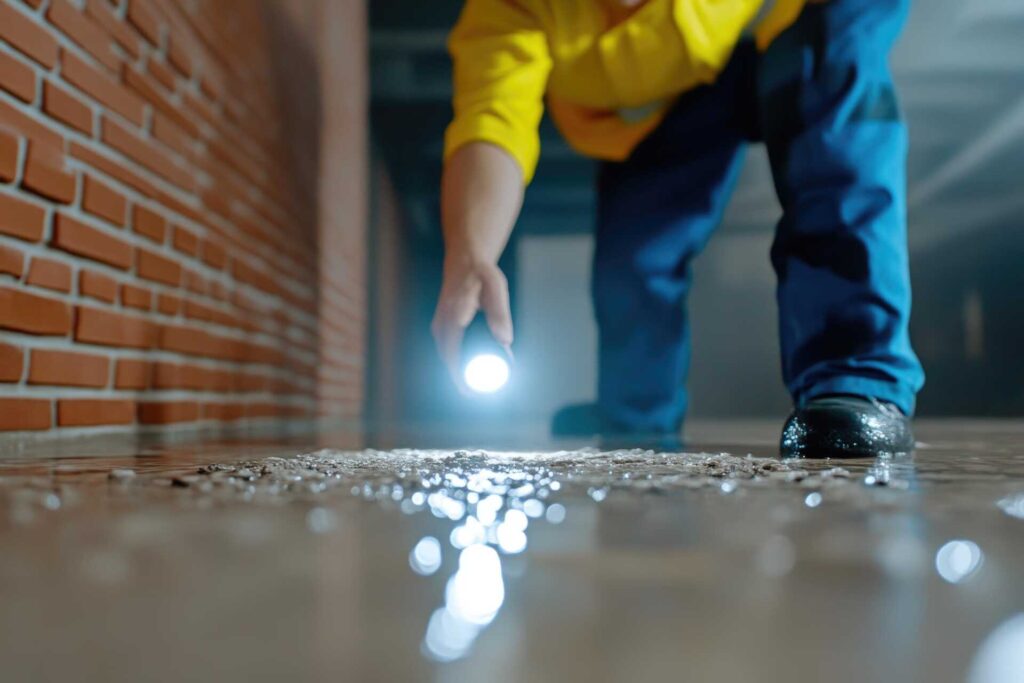
Contents
When dealing with a flooded basement, it’s vital to act swiftly and methodically to prevent extensive damage. You need to assess the situation carefully, identifying any structural issues and documenting the extent of the water damage. Once you’ve done that, removing the water effectively is your next step. But that’s just the beginning; there’s much more to contemplate to ensure your basement is restored properly and protected against future incidents.
Key Takeaways
- Assess the damage by inspecting for structural issues and documenting affected materials with photos for insurance purposes.
- Remove standing water using a submersible pump, followed by a wet/dry vacuum to eliminate residual moisture.
- Clean and disinfect all affected surfaces with a bleach solution or commercial disinfectants to prevent health risks.
- Properly dry out the basement by increasing airflow with fans and dehumidifiers, monitoring humidity levels throughout the process.
- Prevent future flooding by maintaining drainage systems, sealing cracks, and investing in a reliable sump pump.
Assess the Damage Immediately
As soon as you notice water in your basement, it’s vital to assess the damage immediately to prevent further complications. Start by ensuring your safety; if the water is deep or mixed with electricity, don’t enter.
Next, visually inspect the area for structural issues, such as cracks in the walls or foundation. Take note of any materials affected—carpeting, drywall, and insulation often sustain significant damage. Document everything with photos and detailed notes, as this will aid in any insurance claims later.
If the water level is minimal, you can begin an initial damage assessment, identifying the source of the leak. This step is critical for effective emergency response.
Evaluate how long the water has been present, as prolonged exposure can lead to mold growth. By addressing these factors promptly, you’ll set the groundwork for a successful restoration process while ensuring your home remains safe and secure.
Remove Water and Moisture
Once you’ve assessed the damage, it’s vital to remove water and moisture quickly to minimize further harm.
Effective water extraction is imperative at this stage. Here’s how you can tackle this methodically:
Use a Pump: Employ a submersible pump to efficiently remove standing water. Verify it’s suitable for the volume of water you’re dealing with.
Wet/Dry Vacuum: After the bulk of the water is gone, use a wet/dry vacuum to capture residual moisture, especially in carpets and corners.
Dehumidifiers: Set up dehumidifiers to control moisture levels in the air, preventing mold growth and further damage.
Clean and Disinfect Affected Areas
After removing water and moisture, it’s time to focus on cleaning and disinfecting the affected areas to prevent health risks and further damage.
Start by using appropriate cleaning techniques; scrub all surfaces with a mixture of soap and water to eliminate dirt and debris. Pay special attention to corners and crevices where mold can thrive.
Next, select effective disinfecting materials like a bleach solution (one cup of bleach per gallon of water) or commercial disinfectants. Apply these to all surfaces, ensuring you follow the manufacturer’s instructions for contact time.
Don’t forget to wear gloves and masks during this process to protect yourself.
Allow the area to air dry completely, as moisture can promote mold growth.
Dry Out the Basement Properly
To effectively dry out your basement, begin by removing any remaining moisture with high-capacity pumps or wet vacuums.
Once you’ve cleared the standing water, it’s essential to implement effective moisture control and ventilation techniques to prevent mold growth and structural damage.
Follow these steps:
Increase Airflow: Open windows and use fans to circulate air. This helps evaporate moisture more quickly.
Use Dehumidifiers: Set up dehumidifiers to extract moisture from the air, especially in areas where humidity is high.
Inspect Insulation: Check insulation materials for dampness. Replace any that are saturated to ensure proper drying.
Prevent Future Flooding Issues
While it’s impossible to eliminate all risk of flooding, implementing effective preventative measures can greatly reduce the likelihood of future issues.
First, assess your property’s drainage solutions. Confirm that gutters are clean and downspouts direct water at least six feet away from your foundation. Consider installing additional drainage systems, such as French drains, to redirect water flow.
Next, invest in a reliable sump pump. This essential device will help manage excess water and keep your basement dry during heavy rains. Regularly test your sump pump to verify it’s functioning correctly and replace it if it shows signs of wear.
Additionally, seal any cracks in walls or floors with hydraulic cement, as these can become entry points for water.
Finally, consider a backup battery power supply for your sump pump, ensuring it operates even during power outages.
Summary
Restoring a flooded basement can feel like climbing Mount Everest, but with these essential tips, you can conquer the chaos. By evaluating the damage, removing water, and thoroughly cleaning and drying your space, you’ll restore your basement and protect it from future flooding. Remember, proactive measures like maintaining drainage systems and sealing cracks are your best defense. Take these steps seriously, and you’ll transform your basement from a disaster zone into a safe haven once again.
Recent Posts
Why Should Homeowners Prioritize Basement Flood Restoration?
When your basement floods, it’s essential to act swiftly. Delaying restoration can lead to serious
Essential Tips for Basement Flood Restoration
When dealing with a flooded basement, your first step is to ensure safety by turning
Secret Techniques for Storm Damage Repair Success
When storm damage strikes, quick action can make all the difference. Start by thoroughly evaluating
